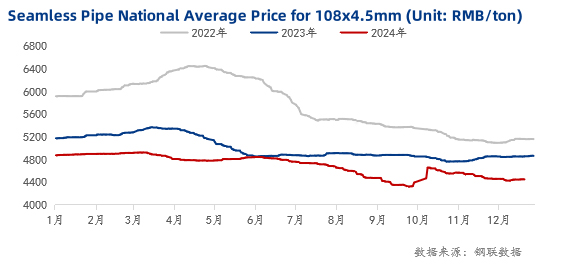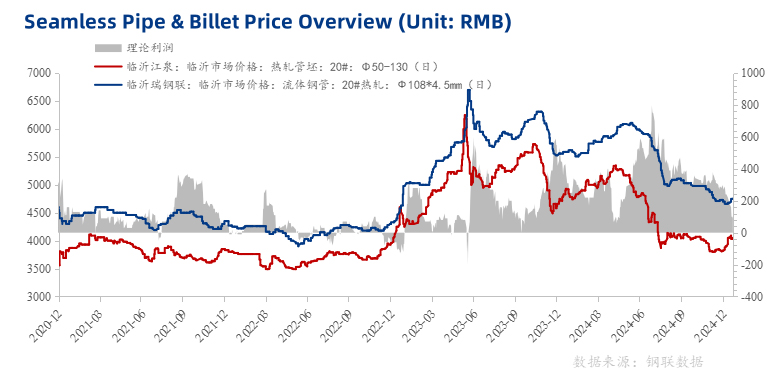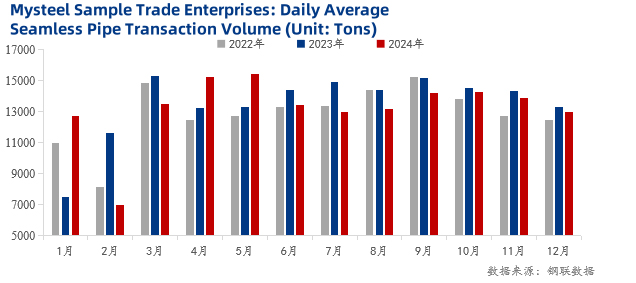Overview: Looking back at the seamless pipe market in 2024, prices remained relatively stable in the first quarter but declined after the Spring Festival. A slight rebound occurred in April-May, followed by a continued downward trend. The third quarter saw significant declines, with prices stabilizing and rebounding in mid-to-late September due to macroeconomic policies. However, as the market entered the fourth quarter, the off-season effects became pronounced, leading to a slow but steady price decline. Meanwhile, prices of raw material billets and theoretical profits for seamless pipes also showed a downward trend this year, with transaction volumes declining year on year, reflecting weaker demand. Exports of seamless pipes also decreased, intensifying industry competition. As the year draws to a close, questions remain about the price trajectory of seamless pipes in the near term.
Nationwide, the average price of seamless pipes in 2024 showed a clear downward trend, with few periods of rebound. Notable price increases were observed only in May-June and October. The third quarter saw the steepest decline, with prices hitting their lowest in nearly three years. According to Mysteel data, as of December 22, the national average price for 20#, 108*4.5 seamless pipes stood at RMB 4,451/ton, down RMB 421/ton for the year, a 12.3% year-on-year decline. With the year-end approaching, seasonal effects are evident, with construction halts and production restrictions in the northern regions and a sluggish trading atmosphere in the south. Seamless pipe prices in December appear to be stuck in a stalemate between potential increases and further declines.

As shown in the chart, the prices of upstream billet materials and finished seamless pipes have generally followed a correlated downward trend. In 2024, billet prices exhibited notable declines, with prices frequently staying below RMB 4,000/ton in the second half of the year.
Regarding profitability, seamless pipe mill profits narrowed throughout the year. For example, as of December 19, sample enterprises in Shandong reported zero profit for 20# hot-rolled Ф108*4.5mm seamless pipes, a week-on-week increase of RMB 30/ton. Meanwhile, in Jiangsu, profits for the same product dropped by RMB 50/ton week-on-week to zero. Both northern and southern pipe mills are struggling at the breakeven point, with profits for toll-rolling enterprises shrinking significantly due to intense industry competition and poor corporate performance.

From a demand perspective, national seamless pipe demand in 2024 showed a slight downward trend. According to Mysteel's survey of 123 sample seamless pipe trading enterprises, while transactions performed well early in the year, showing growth compared to 2023, daily average transactions declined from June onwards, reflecting weakening demand. By the third week of December, daily transactions among sample enterprises averaged 12,141 tons, down 1,490 tons from the previous week (13,632 tons), and 2.19% lower year-on-year.
Regionally, all areas except South China saw significant declines in transactions, with the Northwest experiencing the sharpest drop. Apparent consumption of seamless pipes in 2024 is expected to decrease by about 1.2 million tons compared to 25.9 million tons in 2023.
Additionally, seamless pipe exports also declined slightly this year. According to customs data, China exported 48.7 million tons of seamless pipes in September 2024, with cumulative exports reaching 400.12 million tons from January to September, down 7.4% year-on-year. Exports accounted for 17.2% of total production, a decrease from 17.98% in 2023 but an increase from 16.56% in 2022. Although exports declined, they remained relatively resilient overall.

From a pricing perspective, seamless pipe prices experienced significant declines throughout the year, with the lowest point in three years occurring in September. Year-end prices are expected to remain under pressure.
From a supply perspective, the issue of overcapacity in seamless pipe production persists and is unlikely to improve significantly in the near term. Pipe mills are expected to maintain low production expectations, with the seamless pipe market ending the year under a supply-and-demand imbalance.
From a demand perspective, global economic headwinds, compounded by ongoing geopolitical conflicts, have negatively impacted the steel industry. Domestic demand for seamless pipes continues to weaken, especially as winter intensifies, halting construction in northern regions. While raw material price fluctuations may cause slight adjustments, overall seamless pipe prices are expected to remain on a downward trajectory through the end of the year.